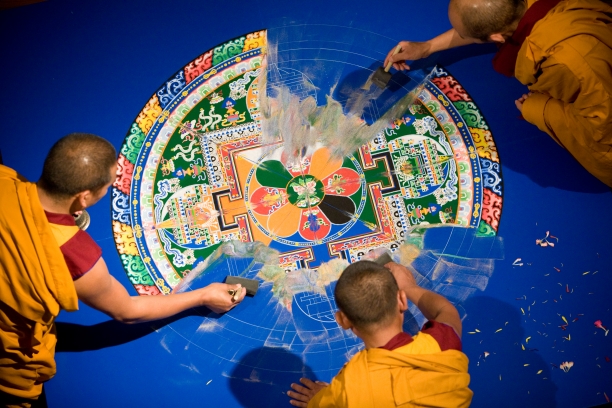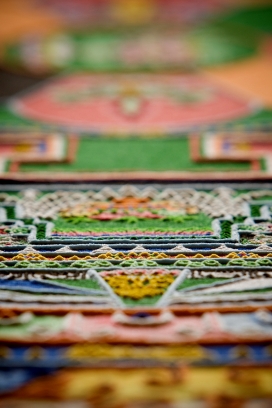Sand mandalas dismantling illustrates impermanence of life

Sand mandala being deconstructed
As the chimes in the University Center bell tower marked the tenth hour on Friday morning, the monks from the Namgyal Monastery donned flowing gold robes, unfurled a Tibetan flag and officially began the dissolution ceremony that concluded the five-day creation and deconstruction of the sand mandala at Lehigh University.
In the hour leading up to the event, more than 150 members of the Lehigh community lined the three levels of the Kenneth R. Woodcock 1965 Rotunda of Linderman Library to observe the dramatic final moments of the rare cultural event.
Promptly at 10 a.m., the monks presented Alice P. Gast, president of Lehigh University, with a “kata,” or a traditional white silk scarf detailed with Tibetan symbols, in a gesture of gratitude for the university’s hospitality.
Other recipients included Debra Nyby, administrative director in the office of the Provost, who is co-chair of the steering committee for the July 2008 visit by the Dalai Lama; and Lehigh staff members Stacy Burger and Bob Yuhasz, who helped coordinate logistics through Facilities Services.
After thanking the monks for their time, attention and serious contemplation in the creation of the sand mandala, Lehigh President Alice P. Gast was succeeded by the Venerable Monk Tenzin Thutop, who detailed the significance of the Chenrezig mandala he helped create.
Chenrezig—a manifestation of all the Buddha’s loving kindness—is embodied in a mandala that symbolizes the residence of five deities, which represent different aspects of overcoming the five delusions of ignorance, anger, attachment, jealousy and pride.
As Thutop explained the immensely complex structure he and his fellow monks created in painstaking detail over the past few days, members of the audience looked on with a combination of solemnity and awe. His narrative was followed by prayers and chants—at turns lyrical and rhythmic—before the monks gathered grains of sand from strategic points on the mandala and bells chimed in the background.
Using a hand-held tool, the monks drew lines traversing the intricate design, and then began brushing the grains into the center of the raised blue platform positioned directly beneath the stained glass ceiling of the Rotunda. The brilliantly colored grains of sand blended into a muddled shade of gray, which was scooped up by hand and poured into a glass urn.
Shortly afterward, the monks filed out in a processional led by Nyby, who bore the American flag, to be transported to Sand Island on the Bethlehem’s North Side. There, in a brief ritual accompanied by the tossing of flower petals from the Rotunda’s altar, the monks released the sand into the flowing Lehigh River to symbolize the kindness and compassion of the deity being released into the world for the benefit of all.
“A wonderful experience”
“It’s wonderful that so many people were able to experience such a rare event,” said Gast after the ceremony. “In speaking with the Venerable Monk Tenzin Thutop, I learned that only two or three of these are created each year. And the dismantling ceremony that followed it was so beautiful and touching…it was a wonderful experience.”
Similarly moved was Carl Moses, deputy provost, who was struck by the physical interpretation of the Buddhist philosophy of impermanence.
“The experience I had as a Western watching this was contradictory since we’re conditioned to preserve beauty,” he said. “I noticed a lot of people sort of choked up over this as the monks dismantled it.”
Bill Newman, professor emeritus of psychology, was one of the members of the audience who allowed himself to “succumb” to the moment.
“I’ve learned that when it comes to religious rituals, you either do that or resist them,” he said. “I find it’s much more practical to succumb, and it makes the whole experience deeper and richer.”
Also on hand at the concluding ceremony was Joshua Cutler, co-director of the Tibetan Buddhist Learning Center in Washington, N.J., which is partnering with Lehigh to bring the Dalai Lama to the university next summer. Cutler said he was pleased that the Lehigh community was able to experience the reverential ceremony.
“The beauty of the art the monks create just underscores their love of life,” he says. “Also, it’s a very real appreciation of just how fleeting life is.”
--Linda Harbrecht
Photos by Douglas Benedict
Posted on:


